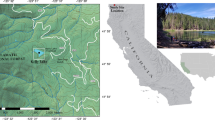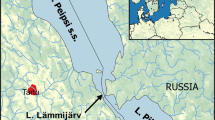Abstract
Significant population growth over the last three decades, as well as efforts to improve surface-water quality mandated by the Clean Water Act, potentially have had opposing influences on aquatic ecosystems in the U.S. Because historical data on water-quality trends are limited over this time period, we developed a diatom-based transfer function to reconstruct chloride, color, acid neutralizing capacity (ANC), total phosphorus (TP), and pH in 55 Minnesota lakes. The lakes span three different ecoregions, as well as the Twin Cities metropolitan area, and differ in their history of settlement and land use, and in surficial geology, climate, and vegetation. Lakes in the Northern Lakes and Forest ecoregion are nearly pristine, whereas those in the other regions likely are strongly affected by urban or agricultural pollutants. Reconstructions of water-chemistry trends since 1970 suggest that recent human activities have had substantial impacts in both urban and rural areas. Chloride concentrations have increased in many Metro lakes, which may be due to road salts, and phosphorus levels have been steady or rising in agricultural regions. The majority of Metro lakes show some decline in TP, although many of the changes are not statistically significant based on our reconstruction techniques. There is no evidence that atmospheric deposition of sulfate or nitrate has caused acidification or changes in trophic state for remote lakes in the northeastern part of the state.
Similar content being viewed by others
References
American Public Health Association, American Water Works Association, and Water Environment Federation 1995. Standard Methods for the Examination of Water and Wastewater. 19th edn. American Public Health Association, Washington, D.C.
Appleby P.G. and Oldfield F. 1978. The calculation of lead-210 dates assuming a constant rate of supply of unsupported 210Pb to the sediments. Catena 5: 1-8.
Bennion H., Juggins S. and Anderson N.J. 1996. Predicting epilimnetic phosphorus concentrations using an improved diatom-based transfer function and its application to lake eutrophication management. Environ. Sci. Techn. 30: 2004-2007.
Bradbury J.P. 1975. Diatom stratigraphy and human settlement in Minnesota. Geological Society of America Special Paper: 1-74. 171.
Bright R.C. 1968. Surface-water chemistry of some Minnesota lakes, with preliminary notes on diatoms. Limnological Research Center Interim Report No. 3: 1-58.
Brugam R.B. 1979. A re-evaluation of the Araphidineae/Centrales index as an indicator of lake trophic status. Freshwat. Biol. 9: 451-460.
Charles D.F. and Smol J.P. 1994. Long-term chemical changes in lakes: Quantitative inferences using biotic remains in the sediment record. In: Baker L. (ed.), Environmental Chemistry of Lakes and Reservoir's, Advances in Chemistry Series 237. American Chemical Society, Washington D.C, pp. 1-31.
Charles D.F., Smol J.P. and Engstrom D.R. 1994. Paleolimnological approaches to biological monitoring. In: Loeb S. (ed.), Biomonitoring of Freshwater Ecosystems. Lewis Publishers, Boca Raton, pp. 233-293.
Gumming B.F., Smol J.P, Kingston J.C., Charles D.F., Birks H.J.B., Camburn K.E. et al. 1992. How much acidification has occurred in Adirondack region lakes (New York, USA) since preindustrial times? Can. J. Fish. Aquat. Sci. 49: 128-141.
Dixit S.S., Smol J.P, Charles D.F., Hughes R.M., Paulsen S.G. and Collins G.B. 1999. Assessing water quality changes in the lakes of the northeastern United States using sediment diatoms. Can. J. Fish. Aquat. Sci. 56: 131-152.
Edmondson W.T. and Lehman J.T. 1981. The effect of changes in the nutrient income on the condition of Lake Washington. Limnol. Oceanogr. 26: 1-29.
Engstrom D.R., Thommes K., Balogh S.J., Swain E.B. and Post H.A. 1999. Trends in atmospheric mercury deposition across Minnesota: evidence from dated sediment cores from 50 Minnesota Lakes. Draft Report to the Legislative Commission on Minnesota Resources.
Fetter C.W. 1994. Applied Hydrogeology, 3rd edn. Prentice Hall, Upper Saddle River, NJ, 691 pp.
Fritz S.C., Kingston J.C. and Engstrom D.R. 1993. Quantitative trophic reconstruction from sedimentary diatom assemblages: a cautionary tale. Freshwat. Biol. 30: 1-23.
Fritz S.C., Cumming B.F., Gasse F. and Laird K.R. 1999. Diatoms as indicators of hydrologic and climatic change in saline lakes. In: Stoermer E.F. and Smol J.P. (eds), The Diatoms: Applications for the Environmental and Earth Sciences. Cambridge University Press, New York, pp. 41-72.
Hall R.I. and Smol J.P. 1992. A weighted-averaging regression and calibration model for inferring total phosphorus concentration from diatoms in British Columbia (Canada) lakes. Freshwat. Biol. 27: 417-434.
Hall R.I. and Smol J.P. 1996. Paleolimnological assessment of long-term water-quality changes in south-central Ontario lakes affected by cottage development and acidification. Can. J. Fish. Aquat. Sci. 53:1-17.
Heiskary S.A. and Wilson C.B. 1989. The regional nature of lake water quality across Minnesota: An analysis for improving resource management. J. Minn. Acad. of Sci. 55: 71-77.
Heiskary S.A., Wilson C.B. and Larsen D.P. 1987. Analysis of regional patterns in lake water quality: Using ecoregions for lake management in Minnesota. Lake Reser. Manage. 3: 337-344.
Jassby A.D., Goldman C.R. and Reuter J.E. 1995. Long-term changes in Lake Tahoe (California-Nevada, U.S.A.) and its relation to atmospheric deposition of algal nutrients. Arch. Hydrobiol. 135: 1-21.
Johengen T.H., Johannsson O.E., Laird Pernie G. and Millard E.S. 1994. Temporal and seasonal trends in nutrient dynamics and biomass measures in Lakes Michigan and Ontario in response to phosphorus control. Can. J. Fish. Aquat. Sci. 51: 2570-2578.
Juggins S. and ter Braak C.J.F., University of Newcastle 1999. CALIBRATE Version 1.0 A program for species-environment calibration by [weighted averaging] partial least squares regression. Unpublished computer program, 25 pp.
Kingston J.C., Cook R.B., Kreis R.G., Camburn K.E., Norton S.A., Sweets PR. et al. 1990. Paleoecological investigation of recent lake acidification in the northern Great Lakes states. J. Paleolim. 4:153-201.
Krammer K. and Lange-Bertalot H. 1986 to 1991. Sufswasserflora von Mitteleuropa. Bd 2, Teil 1-4: Bacillariophyceae. Gustav Fischer Verlag.
Minnesota Pollution Control Agency 2000. Minnesota lake water quality assessment. Minnesota Pollution Control Agency, St. Paul, MN.
Patrick R. and Reimer C.W. 1966. The Diatoms of the United States. Monographic Series of Academy of Natural Sciences of Philadelphia #13. Livingston Publishing Company.
Pienitz R., Smol J.P. and MacDonald G.M. 1999. Paleolimnological reconstruction of Holocene climatic trends from two boreal treeline lakes, Northwest Territories, Canada. Arct. Alp. Res. 31: 82-93.
Reavie E.D. and Smol J.P. 2001. Diatom-environmental relationships in 64 alkaline southeastern Ontario (Canada) lakes: a diatom-based model for water quality reconstructions. J.Paleolim. 25: 25-42.
Reavie E.D., Hall R.I. and Smol J.P. 1995a. An expanded weighted-averaging model for inferring past total phosphorus concentrations from diatom assemblages in eutrophic British Columbia (Canada) lakes. J. Paleolim. 14: 49-67.
Reavie E.D., Smol J.P. and Carmichael N.B. 1995b. Postsettlement eutrophication histories of six British Columbia (Canada) lakes. Can. J. Fish. Aquat. Sci. 52: 2388-2401.
Schindler D.W, Bayley S.E., Parker B.R., Beaty K.G., Cruikshank D.R., Fee E.J. et al. 1996. The effects of climatic warming on the properties of boreal lakes and streams at the Experimental Lakes Area, northwestern Ontario. Limnol. Oceanogr. 41: 1004-1017.
Siver PA., Lott A.M., Cash E., Moss J. and Marsicano L.J. 1999. Century changes in Connecticut, U.S.A., lakes as inferred from siliceous algal remains and their relationships to land-use change. Limnol. Oceanogr. 44: 1928-1935.
Spawn R.L., Hoagland K.D. and Siegfried B.D. 1997. Effects of alachlor on an algal community from a midwestem agricultural stream. Environmental Toxicology and Chemistry 16: 785-793.
ter Braak C.J.F. 1987. CANOCO-a FORTRAN program for canonical community ordination by [partial] [detrended] [canonical] correspondence analysis, principal components analysis and redundancy analysis (version 2.1) ITI-TNO.Wageningen, 95 pp.
Tester J.R. 1995. Minnesota's Natural Heritage, An Ecological Perspective. University of Minnesota Press, Minneapolisa, MN, 332 pp.
Wetzel R.G. 1983. Limnology, 2nd edn. Saunders College Publishing, Fort Worth, 767 pp.
Author information
Authors and Affiliations
Rights and permissions
About this article
Cite this article
Ramstack, J., Fritz, S., Engstrom, D. et al. The Application of a Diatom-based Transfer Function to Evaluate Regional Water-Quality Trends in Minnessota Since 1970. Journal of Paleolimnology 29, 79–94 (2003). https://doi.org/10.1023/A:1022869205291
Issue Date:
DOI: https://doi.org/10.1023/A:1022869205291




